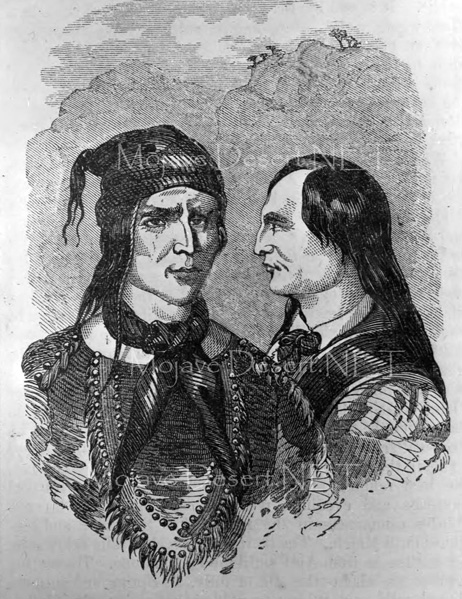Walkara
Ute horsethief and slave traderA Powerful Ute Leader
AKA Wakara, Walker, c. 1815-1855
In short:
Chief Wakara of the Timpanogots Utes is a legend in the West. When he was alive, some believed he could be in many places at once, and after his death, his legend only continued to grow. He was born around 1815, and came to power in his band as the Western exploration and migration boom was beginning. In the early days of Utah settlement, Wakara mostly helped the settlers. He sometimes traded using less than honorable means, but he also served as an important negotiator and ally for the Mormon settlers. Later, he resented the settlers’ taking over his land, and he and his followers started the “Walker War” by raiding and attacking the new settlements.
More of the story:
A strong leader
Wakara was a leader in the Timpanogots Ute band in the first part of the 19th century. Because he spoke both English and Spanish, he became a successful trader. He specialized in trading horses and slaves.
A thief and slave trader
He got many of his horses by stealing them from ranches in California. He also stole the slaves. He and his men would raid Paiute bands and take women and children prisoner. He would sell the slaves to Spanish or Mexican traders and explorers, who would take them back to New Mexico to work in the mines or as domestic servants. In return, Wakara would get guns, ammunition, and other goods. He also sold children to the Mormon settlers, threatening to kill the children if he couldn't sell them.
Trouble
Brigham Young didn’t like New Mexican traders associating with the Utes. He made a proclamation outlawing New Mexican traders in Utah Territory.
This didn’t help Wakara’s business! He began to get angry about the large disruption the Mormons were creating for his people. His anger boiled over after a Mormon settler killed a member of his band near Springville during a fight about a trade.
His Utes began to raid Mormon settlements, and the Mormons began to retaliate. This conflict is called the “Walker War.” It caused much fear, bloodshed, and deaths of innocent people--on both sides.
Defeat - and peace
Brigham Young finally ordered that the settlers end all trading with the Utes. He then sent a negotiator to meet with Wakara, and eventually Young met with him himself. Wakara had learned what all Native American leaders learned: that they couldn't win fighting against the Anglo Americans.
Wakara agreed to stop the fighting and live peacefully with the Mormons who had taken over the lands his tribe had used for centuries. He died not long after that.
source - UTAH.GOV
Also see:
Cajon Pass
The horses bred on the ranchos in the south were beautiful, strong, and well-fed creatures bringing 10 times the price in New Mexico and much more than that in Missouri than could be had for them in Los Angeles. This was attractive to horse thieves ...Old Spanish Trail
Horse and mule theft was common, both by regular traders and adventurers. Americans claiming to be beaver trappers, fugitive Indians from the missions, Indians from the frontiers, and New Mexicans were teaming together to ...Indian Slave Trade
The institution of slavery has had wide distribution in time and geography and in technique. It has existed throughout the world, involving ...Other Facets of this Indian Slavery:
Indian Slave Trade(24) Walkara definitely made two trips into California and perhaps made many more ... From the following Lorton quote, it might be assumed that Walkara also ...Vanyume Indians
1851 Juan Maria Lugo and Indian cowboys ambushed near Cacameat by Ute horse thieves under Chief Walkara, Ignacio Palomares and other rider were ambushed ...Smith, Thomas L. - Mojave Desert
In one incident, Smith guided around 150 Utes under the leadership of Walkara across the Sierra Nevada, stealing at least several hundred horses from ...Cronology/timeline, Cahuilla Indians
The Mountain Band also lent support to a U.S. Army expedition led by then Lieutenant Edward Fitzgerald Beale, defending the party against attacks by Walkara ...The Greatest Horse Thief

Walkara and his brother Arapeen (on the right), from a book printed in 1855
The cloud of dust from the stolen animals could be seen for 50 miles
I've heard there are only 3 seasons in the desert, spring, summer and winter. From my observations I would say this is pretty much true.
Walkara, an Ute Indian known as the 'Greatest Horsethief in History,' was also a slave trader and chief of his own band of renegades (or outcasts). It would be in the autumn when he would steal 3,000 or more horses from the rancheros in the green valleys of southern California and drive them relentlessly through the passes and across the desert, kidnapping Piute men, women and children if they were handy along the way. This became known as the fourth season, when 'Walkara conducts his raids.'